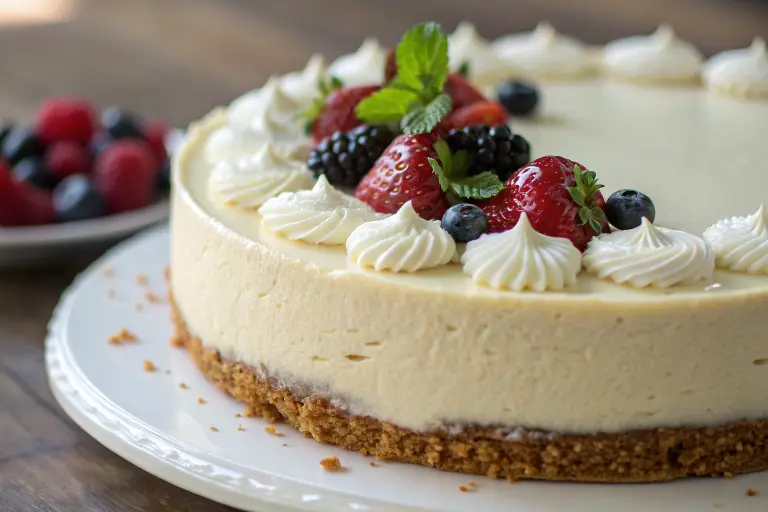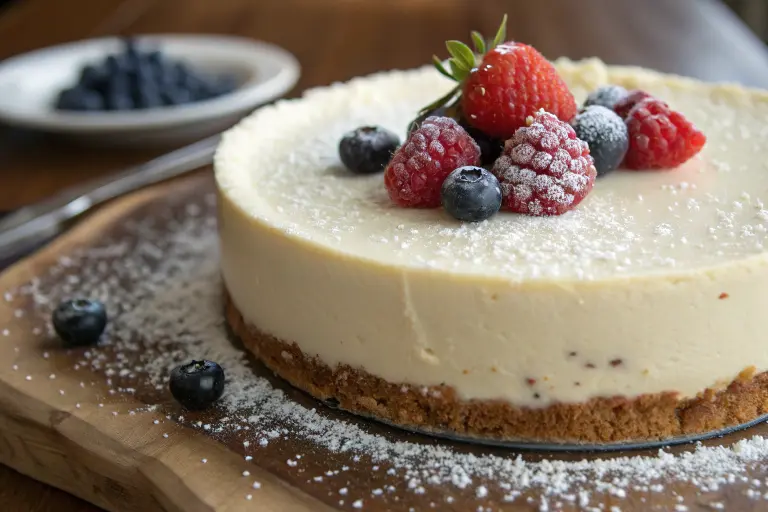There’s nothing more frustrating than spending hours preparing a no-bake cheesecake, only to find that it hasn’t set properly. You may be asking yourself, ” Why won’t my no bake cheesecake set?”, especially after following all the instructions to the letter. A runny or overly soft cheesecake can be disheartening, but don’t worry, this is a common issue that can be fixed with the right knowledge. In this guide, we’ll explore the top reasons why your no-bake cheesecake may not be setting and provide simple, practical solutions to ensure your cheesecake turns out perfectly every time.
Understanding the factors behind a no-bake cheesecake’s failure to set is crucial for anyone looking to master this dessert. Whether it’s the incorrect use of gelatin, not enough chilling time, or an excess of liquid, “Why won’t my no bake cheesecake set?” is a question that can be answered with the right troubleshooting steps. By the end of this article, you’ll not only know why it happens but also how to avoid it in the future, leading to a smooth, creamy, and perfectly set cheesecake. So, let’s dive into the possible reasons behind your cheesecake mishap and learn how to fix it.
Understanding the Basics of No-Bake Cheesecake
Before diving into troubleshooting, it’s important to understand how a no-bake cheesecake works. Unlike traditional cheesecakes that require baking, no-bake cheesecakes rely on a chilled setting process, usually in the fridge or freezer. The key to a perfect no-bake cheesecake is getting the right balance of ingredients and giving the cheesecake enough time to set properly.
The Key Ingredients in No-Bake Cheesecake
A typical no-bake cheesecake includes these essential components:
- Cream Cheese: Provides a smooth and creamy texture.
- Heavy Cream: Adds richness and helps create a light, airy filling.
- Sugar: Sweetens the mixture.
- Gelatin or Agar-Agar: Helps the cheesecake set without baking.
- Graham Cracker Crust: The base of the cheesecake.
Each of these ingredients plays a vital role in the cheesecake’s texture and setting process. If one or more of them is not used correctly, it could result in a cheesecake that doesn’t set.
Common Reasons Why Your No-Bake Cheesecake Won’t Set
If you’re asking, “Why won’t my no-bake cheesecake set?”, there are several reasons that could explain why your cheesecake didn’t firm up as expected. Let’s break down the most common culprits.
1. Insufficient Gelatin or Agar-Agar
Gelatin is the key ingredient in most no-bake cheesecakes for helping them set. If you didn’t use enough gelatin, or if it wasn’t properly dissolved, your cheesecake will likely be too runny to hold its shape.
- Solution: Check the recipe and ensure you’re using the correct amount of gelatin for the quantity of cheesecake you’re making. Additionally, make sure to dissolve the gelatin properly by blooming it in cold water before heating.
2. Not Enough Chilling Time
Sometimes, impatience can lead to a cheesecake that hasn’t had enough time to set in the fridge. If you remove it too early, it will be too soft to hold its shape.
- Solution: Allow your cheesecake to chill in the fridge for at least 4 hours, preferably overnight. This gives the gelatin enough time to work its magic.
3. Too Much Liquid in the Filling
Excess moisture in the filling can cause your cheesecake to fail to set properly. This could be from using too much heavy cream or not properly draining any liquid from the cream cheese.
- Solution: Be mindful of how much liquid you’re adding. Use full-fat cream cheese and make sure to drain any excess moisture from it before mixing. Also, avoid adding too much heavy cream; stick to the recommended amount.
4. The Wrong Type of Cream Cheese
Not all cream cheeses are created equal. Some varieties may have higher moisture content, which can lead to a less firm texture.
- Solution: Use high-quality, full-fat cream cheese for the best results. Make sure it is softened to room temperature before mixing it with other ingredients to ensure smoothness and proper incorporation.
5. Incorrect Gelatin Preparation
If gelatin isn’t prepared properly, it may fail to set your cheesecake. Gelatin needs to be bloomed in cold water and then dissolved by heating gently. If this step is skipped or rushed, the gelatin won’t activate properly.
- Solution: Always bloom gelatin in cold water for about 5 minutes before gently heating it until it fully dissolves. This ensures the gelatin will set the cheesecake properly.
6. Not Enough Time for the Gelatin to Set
Even if you’ve prepared the gelatin correctly, it still requires time to set the cheesecake. If the cheesecake is disturbed or moved before the gelatin has had enough time to work, it might not set properly.
- Solution: Once you’ve poured the cheesecake mixture into the pan, avoid moving or shaking it until it has had enough time to set completely. Give it several hours in the fridge or even overnight for the best results.

How to Fix a No-Bake Cheesecake That Won’t Set
If you’ve already made the cheesecake and discovered it isn’t setting properly, don’t despair. There are a few ways to troubleshoot and potentially fix the issue.
1. Add More Gelatin
If the cheesecake hasn’t set because there wasn’t enough gelatin, you can add more to salvage the dessert. Dissolve some additional gelatin in warm water and fold it into the already-made cheesecake filling.
- How to do it: Heat 1-2 teaspoons of gelatin in a small amount of water, let it cool slightly, and fold it into your mixture. Then, return the cheesecake to the fridge and allow it to set again.
2. Chill Longer
Sometimes, the solution is simply giving it more time in the fridge. If you rushed the chilling process, try putting the cheesecake back in the fridge for an extended period, preferably overnight.
- Tip: If you’re in a hurry, try chilling it in the freezer for about 30-60 minutes to help it set faster. Just be sure not to freeze it completely.
3. Adjust the Ingredients
If your filling was too runny, you might need to adjust the proportions of cream cheese, sugar, and cream. Adding more cream cheese or even a bit of cornstarch may help thicken the filling.
How to Prevent No-Bake Cheesecake from Not Setting in the Future
Preventing issues with setting begins with ensuring the right steps are followed from the beginning. Here’s what you can do to avoid problems in the future:
- Use high-quality ingredients: Make sure your cream cheese, heavy cream, and gelatin are fresh and of good quality.
- Follow the recipe precisely: Don’t try to rush through the recipe. Follow every step, especially the gelatin preparation and chilling times.
- Test your fridge’s temperature: Ensure your fridge is cold enough. A temperature of 40°F (4°C) or lower is ideal for setting a no-bake cheesecake.
Tips for a Perfect No-Bake Cheesecake Every Time
To help you get it right every time, here are some extra tips for a foolproof no-bake cheesecake:
1. Use Room Temperature Ingredients
Using room temperature ingredients is one of the most critical steps in making a smooth no-bake cheesecake. Cold ingredients, particularly cream cheese, can lead to a lumpy filling that doesn’t incorporate well with other components like whipped cream or sugar. This can create air pockets and uneven texture in the cheesecake, making it more likely that it won’t set properly.
- Why it matters: Cream cheese, when cold, is firmer and harder to mix. If it’s not softened to room temperature, it may not blend smoothly with the other ingredients, resulting in an uneven mixture. This can lead to a cheesecake that’s too runny or fails to set properly.
- How to prepare: Take your cream cheese, sour cream (if using), and any other refrigerated ingredients out of the fridge 30–60 minutes before you plan to start mixing. To speed up the process, cut the cream cheese into small cubes so it softens faster. When mixing, ensure that all ingredients, including heavy cream, are at a similar temperature for better incorporation.
- Pro tip: If you’re short on time, you can microwave cream cheese in short 10-second intervals, checking after each, but avoid overheating it. Overheated cream cheese can cause the mixture to separate or curdle.
2. Pre-Chill the Pan
You may not think much about the pan, but the temperature of the pan can influence how your cheesecake sets. If you pour your cheesecake mixture into a warm or room-temperature pan, it can cause the filling to soften too quickly, leading to an uneven or incomplete set. A pre-chilled pan keeps the filling cool as it’s poured in, providing a firmer base from the start.
- Why it matters: A cold pan helps maintain the right temperature for the cheesecake mixture as it begins to set. If the pan is warm, the cheesecake filling may soften prematurely, making it difficult to achieve that perfect, firm consistency you’re aiming for.
- How to prepare: If you’re using a springform pan, place it in the refrigerator or freezer for 15–20 minutes before you start filling it with your cheesecake mixture. This simple step gives you more control over the setting process, ensuring your cheesecake sets evenly and doesn’t lose shape.
- Pro tip: If you’re using a non-springform pan, line it with parchment paper or plastic wrap to help release the cheesecake once it’s set. This makes the removal process easier without disturbing the shape.
3. Use the Right Gelatin
Gelatin is essential for helping your no-bake cheesecake set, but the type and quality of gelatin you use can significantly impact the final result. Many people wonder, “Why won’t my no bake cheesecake set?”, and the culprit often lies in improper gelatin usage. Unflavored gelatin is the ideal choice for cheesecakes, as it provides the necessary firmness without affecting the taste or texture.
- Why it matters: Using flavored gelatin can not only alter the flavor profile of your cheesecake but can also affect the texture. On the other hand, agar-agar, a plant-based alternative, sets differently than gelatin and requires specific handling, so it’s important to follow the recipe instructions carefully if you’re using it.
- How to prepare: If you’re using unflavored gelatin, begin by “blooming” it in cold water. Sprinkle the gelatin over cold water and let it sit for about 5–10 minutes to hydrate. After blooming, gently heat it in a microwave or over a double boiler until it dissolves completely. Once dissolved, allow it to cool slightly before incorporating it into your cheesecake mixture.
- Pro tip: When using gelatin, avoid heating it to boiling temperature, as this can weaken its setting properties. Make sure it’s only dissolved and slightly warm to the touch. If you’re working with agar-agar, follow the specific preparation instructions, as it sets at a higher temperature than gelatin and requires boiling.

FAQs: No-Bake Cheesecake Troubleshooting
❓ Why is my no-bake cheesecake base so hard?
A hard cheesecake base is usually caused by over-pressing the crumbs or using too much butter. Try using less butter and pressing the crumbs more lightly to get a softer base.
❓ Will my no-bake cheesecake set in the freezer?
Yes, your no-bake cheesecake can set in the freezer, but it should be transferred to the fridge after 30-60 minutes to prevent it from freezing too hard.
❓ How to fix a cheesecake that didn’t set?
If your cheesecake didn’t set, add more gelatin, dissolve it properly, and gently fold it into the mixture. Then, chill for several more hours.
❓ What to do if no-bake cheesecake doesn’t set?
Check if you used enough gelatin, ensure proper chilling time, and ensure your ingredients were at room temperature. If needed, return it to the fridge or add more gelatin.
Conclusion: Troubleshooting Your No-Bake Cheesecake
Making a no-bake cheesecake that sets perfectly is not as challenging as it may seem once you have a clear understanding of the key factors at play. If you’ve ever wondered, “Why won’t my no bake cheesecake set?”, the solution usually lies in a few critical elements: using the right gelatin, allowing sufficient chilling time, and ensuring your ingredients are at room temperature. By applying these simple tips, you’ll be able to achieve a smooth, creamy, and perfectly set cheesecake every time. With practice, your cheesecakes will be so consistent that you’ll impress family and friends with your flawless desserts.
As you gain confidence in your cheesecake-making skills, consider trying some variations to keep things exciting in the kitchen. If you’re a fan of quick and easy desserts, you might want to try our Microwave Cheesecake Recipe for a speedy alternative or indulge in our delicious Biscoff Cheesecake Bars for a unique twist on a classic favorite. And if you’re looking for a wholesome breakfast treat, don’t miss our healthy Banana Oatmeal Pancakes that are both satisfying and nutritious.
For more inspiration and delicious recipes, check out Chaynez Recipes. There, you’ll find a wide variety of mouthwatering dishes that cater to all tastes and dietary preferences. Whether you’re after something sweet, savory, or a bit of both, there’s a recipe for everyone. Keep experimenting and enjoy the process of creating amazing meals right from your kitchen!






